ModuleNotFoundError: No module named 'requests' in Python
Last updated: Apr 8, 2024
Reading time·12 min

# ModuleNotFoundError: No module named 'requests' in Python
The Python "ModuleNotFoundError: No module named 'requests'" occurs when we
forget to install the requests module before importing it or install it in an
incorrect environment.
To solve the error, install the module by running the pip install requests
command.

Open your terminal in your project's root directory and install the requests
module.
# 👇️ In a virtual environment or using Python 2 pip install requests # 👇️ For Python 3 (could also be pip3.10 depending on your version) pip3 install requests # 👇️ If you get a permissions error sudo pip3 install requests pip install requests --user # 👇️ If you don't have pip in your PATH environment variable python -m pip install requests # 👇️ For Python 3 (could also be pip3.10 depending on your version) python3 -m pip install requests # 👇️ Using py alias (Windows) py -m pip install requests # 👇️ Alternative for Ubuntu/Debian sudo apt-get install python3-requests # 👇️ alternative for CentOS sudo yum install python-requests # 👇️ For Anaconda conda install -c anaconda requests # 👇️ For Jupyter Notebook !pip install requests
After you install the requests package, try importing it as follows.
import requests def make_request(): res = requests.get('https://reqres.in/api/users') print(res.json()) make_request()
# Common reasons the error occurs
The error occurs for multiple reasons:
- Not having the
requestspackage installed by runningpip install requests. - Installing the package in a different Python version than the one you're using.
- Installing the package globally and not in your virtual environment.
- Your IDE running an incorrect version of Python.
- Naming your module
requests.pywhich would shadow the official module. - Declaring a variable named
requestswhich would shadow the imported variable.
If the error persists, get your Python version and make sure you are installing the package using the correct Python version.
python --version

For example, my Python version is 3.10.4, so I would install the requests
package with pip3.10 install requests.
pip3.10 install requests # 👇️ If you get a permissions error use pip3 (NOT pip3.X) sudo pip3 install requests
Notice that the version number corresponds to the version of pip I'm using.
If the PATH for pip is not set up on your machine, replace pip with
python3 -m pip:
# 👇️ Make sure to use your version of Python, e.g. 3.10 python3 -m pip install requests
If the error persists, try restarting your IDE and development server/script.
# Check if the package is installed
You can
check if you have the requests package installed
by running the pip show requests command.
# 👇️ Check if you have requests installed pip show requests # 👇️ If you don't have pip set up in PATH python -m pip show requests
The pip show requests command will either state that the package is not
installed or show a bunch of information about the package, including the
location where the package is installed.
# Make sure your IDE is using the correct Python version
If the package is not installed, make sure your IDE is using the correct version of Python.
requests package using the incorrect version or your IDE might be set up to use a different version.For example, In VSCode, you can press CTRL + Shift + P or (⌘ + Shift + P
on Mac) to open the command palette.
Then type "Python select interpreter" in the field.

Then Select the correct Python version from the dropdown menu.

# Install the package in a Virtual Environment
If you are using a virtual environment, make sure you are installing requests
in your virtual environment and not globally.
You can try creating a virtual environment if you don't already have one.
# 👇️ Use the correct version of Python when creating VENV python -m venv venv # 👇️ Activate on Unix or MacOS source venv/bin/activate # 👇️ Activate on Windows (cmd.exe) venv\Scripts\activate.bat # 👇️ Activate on Windows (PowerShell) venv\Scripts\Activate.ps1 # 👇️ Install requests in your virtual environment pip install requests
If the python -m venv venv command doesn't work, try the following 2 commands:
python3 -m venv venvpy -m venv venv
Your virtual environment will use the version of Python that was used to create it.
requests.py because that would shadow the original requests module.You also shouldn't be declaring a variable named requests as that would also
shadow the original module.
# Try reinstalling the package
If the error is not resolved, try to uninstall the requests package and then
reinstall it.
# 👇️ Check if you have requests installed pip show requests # 👇️ If you don't have pip set up in PATH python -m pip show requests # 👇️ Uninstall requests pip uninstall requests # 👇️ If you don't have pip set up in PATH python -m pip uninstall requests # 👇️ Install requests pip install requests # 👇️ If you don't have pip set up in PATH python -m pip install requests
Try restarting your IDE and development server/script.
You can also try to upgrade the version of the requests package.
pip install requests --upgrade # 👇️ If you don't have pip set up in PATH python -m pip install requests --upgrade
# Import "requests" could not be resolved from source Pylance
The error "Import "requests" could not be resolved from source Pylance" occurs
when the requests module is not installed or you have selected the incorrect
Python interpreter in your IDE (e.g. Visual Studio Code).
To solve the error, install requests and select the correct Python interpreter
in your IDE.

Import "requests" could not be resolved from source Pylance(reportMissingModuleSource) [Ln 1, Col 8]
# Make sure the correct Python interpreter is selected in your IDE
If you have multiple Python versions installed on your machine, you might have
installed the requests package using the incorrect version or your IDE might
be set up to use a different version.
For example, In Visual Studio Code you can:
- Press
CTRL + Shift + Por (⌘+Shift+Pon macOS) to open the command palette.
Then type "Python select interpreter" in the search field.

- Select the correct Python version from the dropdown menu.

If the error persists, try restarting your IDE and development server/script. VSCode often glitches and a reboot resolves the issue.
If the error is not resolved, try to use the Visual Studio Code terminal to
install the requests module.
You can press CTRL + ` (Backtick) on your keyboard to open the Visual Studio code terminal.
CTRL+Shift+P and then type "View: Toggle Terminal".
Once you open the terminal, Visual Studio Code will automatically activate your virtual environment (if you have one).
Run the pip install requests command.
pip install requests
If the error persists, try to select the Python interpreter by specifying the path:
- Press
CTRL + Shift + Por (⌘+Shift+Pon Mac) to open the command palette. - Type "Python select interpreter" in the field.

- Select "Enter interpreter path...".

- Click on "Find".

- In the window that opens, navigate to your Python executable:
- If you have a virtual environment on Windows, click on your
venvfolder, then double-click on theScriptsfolder, select thepython.exefile and then Select interpreter.
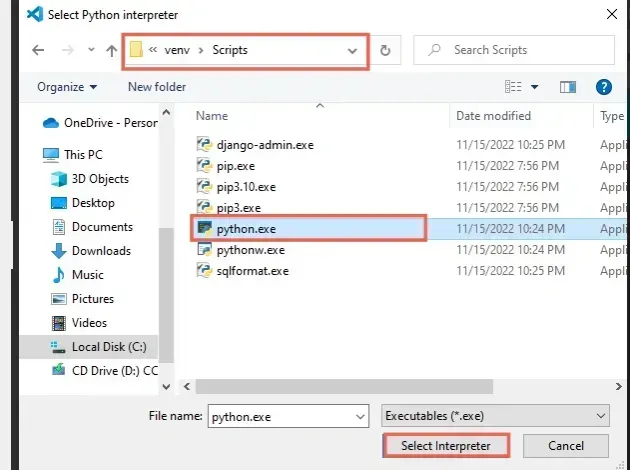
- If you have a virtual environment on macOS or Linux, click on your
venvfolder, then double-click on thebinfolder, select thepythonfile and then Select interpreter.

- If you don't have a virtual environment, use one of the following commands to
get your path to your
python.exeorpythonexecutable, specify the path to the file and select the executable.
where python python -c "import sys; print(sys.executable)"

If the error persists, try restarting your IDE and development server/script.
# Alternatively, use a comment to disable the warning
If none of the suggestions helped, you can use a comment to disable the Pylance warning in your IDE.
import requests # type: ignore print(requests)
You simply have to add the # type: ignore command on the same line as the
import statement to disable the check for the specific import.
requests.# Table of Contents
- Install requests on Windows
- Install requests on macOS or Linux
- Install requests in Visual Studio Code
- Install requests in PyCharm
- Install requests in Anaconda
- Install requests in Jupyter Notebook
# Install requests on Windows
To install the requests module on Windows:
- Type CMD in the search bar and open the Command Prompt application.
- Type
pip install requestsand press Enter.
pip install requests # 👇️ For Python 3 pip3 install requests # 👇️ If you don't have pip in your PATH environment variable python -m pip install requests # 👇️ For Python 3 python3 -m pip install requests # 👇️ Using py alias py -m pip install requests # 👇️ If you get a permissions error pip install requests --user # 👇️ For Anaconda conda install -c anaconda requests
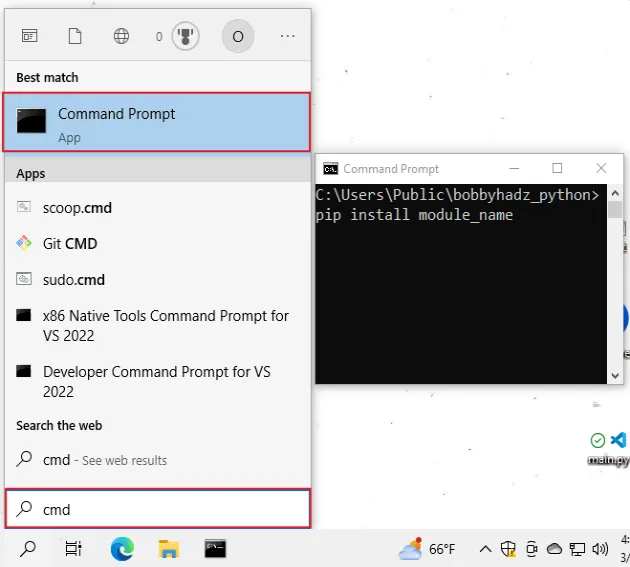
If the command doesn't succeed, try running CMD as an administrator.
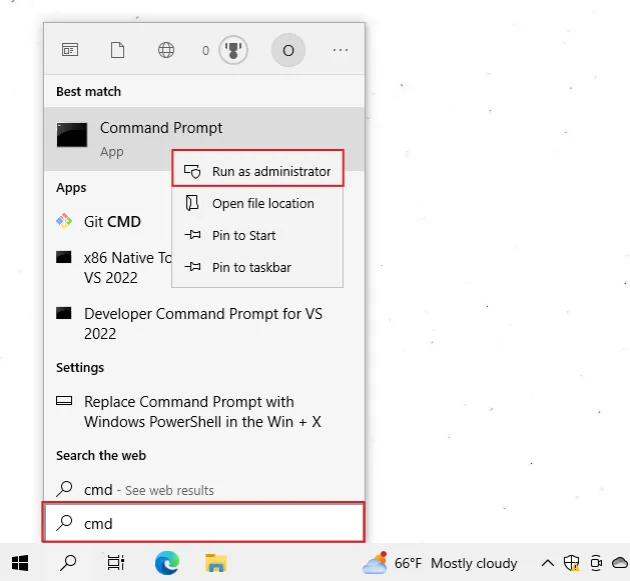
If you get the error
'pip' is not recognized as an internal or external command,
use the python -m command when installing requests.
python -m pip install requests python3 -m pip install requests py -m pip install requests
Alternatively, you can install the requests module in a virtual environment:
- Open the root directory of your project.
- Press
Shiftand right-click in Explorer.
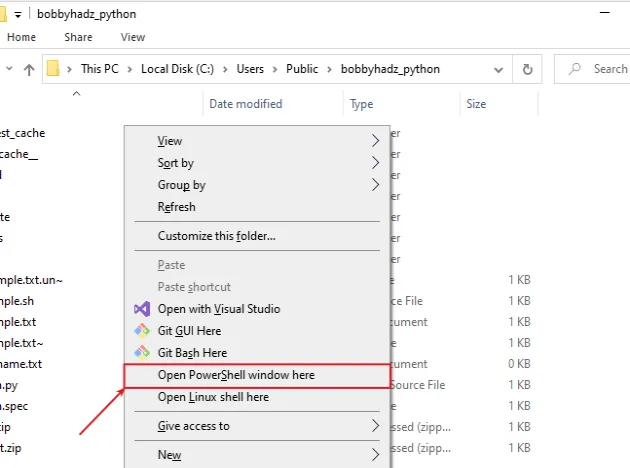
- Click on "Open PowerShell window here".
- Run the following commands.
# 👇️ Might also be: "python3 -m venv venv" python -m venv venv # 👇️ Activate on Windows (PowerShell) venv\Scripts\Activate.ps1 # 👇️ Activate on Windows (cmd.exe) venv\Scripts\activate.bat # 👇️ Install requests in your virtual environment pip install requests
If the python -m venv venv command doesn't work, try the following 2 commands:
python3 -m venv venvpy -m venv venv.
If you see an error message that ps1 cannot be loaded because running scripts is disabled on this system, run the following command, type "yes" when prompted and rerun the activation command.
Set-ExecutionPolicy RemoteSigned -Scope CurrentUser
requests module is installed by using the pip show requests command.pip show requests pip3 show requests python -m pip show requests python3 -m pip show requests
The pip show requests command will either state that the package is not
installed or show a bunch of information about the package, including the
location where the package is installed.
# Install requests on macOS or Linux
To install requests on macOS or Linux:
- Search for "terminal" and start the application.
- Type
pip install requestsand press Enter.
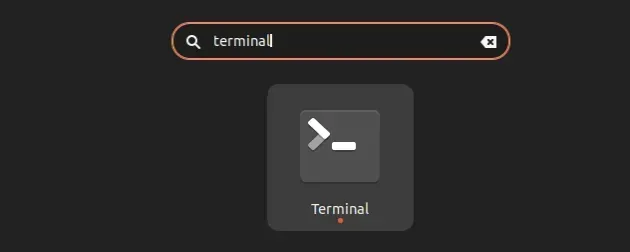
pip install requests # 👇️ For Python 3 pip3 install requests # 👇️ If you get a permissions error sudo pip3 install requests # 👇️ If you don't have pip in your PATH environment variable python -m pip install requests # 👇️ For Python 3 python3 -m pip install requests # 👇️ Alternative if you get a permissions error pip install requests --user # 👇️ For Anaconda conda install -c anaconda requests

If you get an error that pip isn't found, use the python -m command.
python -m pip install requests python3 -m pip install requests
If you get a permissions error, prefix the command with sudo.
sudo pip install requests sudo pip3 install requests
Alternatively, you can install the requests package in a virtual environment:
- Open your terminal in the root directory of your project.
- Run the following commands.
# 👇️ Could also be "python -m venv venv" python3 -m venv venv # 👇️ Activate virtual env on macOS or Linux source venv/bin/activate # 👇️ Install requests in your virtual environment pip install requests
Your virtual environment will use the version of Python that was used to create it.
python3 -m venv venv command doesn't work, use python -m venv venv instead.You can use the pip show command to verify
requests has been installed
successfully.
pip show requests pip3 show requests python -m pip show requests python3 -m pip show requests
The pip show requests command will either state that the package is not
installed or show a bunch of information about the package.
# Install requests in Visual Studio Code
To install requests in Visual Studio Code:
- Press CTRL + ` (Backtick) on your keyboard to open the terminal.
- Run the
pip install requestscommand to install therequestsmodule.
pip install requests # 👇️ For Python 3 pip3 install requests # 👇️ If you get a permissions error sudo pip3 install requests # 👇️ If you don't have pip in your PATH environment variable python -m pip install requests # 👇️ For Python 3 python3 -m pip install requests # 👇️ Using py alias py -m pip install requests # 👇️ Alternative if you get a permissions error pip install requests --user

CTRL+Shift+P and then type "View: Toggle Terminal".When installing Python modules in Visual Studio code, make sure that your IDE is configured to use the correct Python version.
Press CTRL+Shift+P or (⌘ + Shift + P on Mac) to open the command
palette.
Then type "Python select interpreter" in the field.

Then Select the correct Python version from the dropdown menu.

You can use the python --version command if you need to get your version of
Python.
python --version python3 --version

You can also try creating a virtual environment if you don't already have one.
# 👇️ Could also be "python -m venv venv" or "py -m venv venv" python3 -m venv venv # 👇️ Activate on Unix or MacOS source venv/bin/activate # 👇️ Activate on Windows (cmd.exe) venv\Scripts\activate.bat # 👇️ Activate on Windows (PowerShell) venv\Scripts\Activate.ps1 # 👇️ Install requests in your virtual environment pip install requests
Your virtual environment will use the version of Python that was used to create it.
# Install requests in PyCharm
To install requests in PyCharm:
- Press
Alt+F12on your keyboard to open the terminal. - Run the
pip install requestscommand to install therequestsmodule.
pip install requests # 👇️ For Python 3 pip3 install requests # 👇️ If you get a permissions error sudo pip3 install requests # 👇️ If you don't have pip in your PATH environment variable python -m pip install requests # 👇️ For Python 3 python3 -m pip install requests # 👇️ Using py alias py -m pip install requests # 👇️ Alternative if you get a permissions error pip install requests --user

Alternatively, you can use the IDE itself to install the module.
- Click on "File" > "Settings" > "Project" > "Python Interpreter".
- Click on the
+icon and typerequests. - Click on "Install Package".
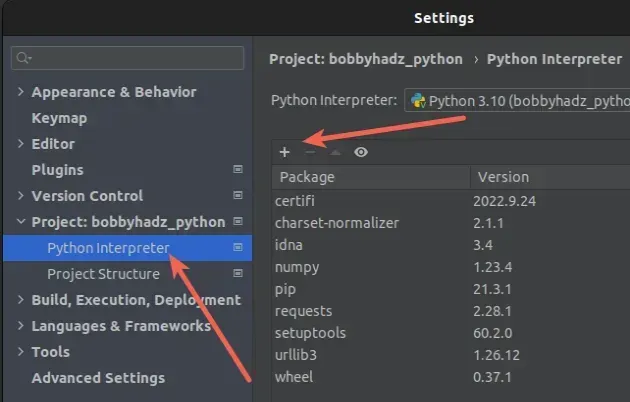
Click on "File" > "Settings" > "Project" > "Python Interpreter".
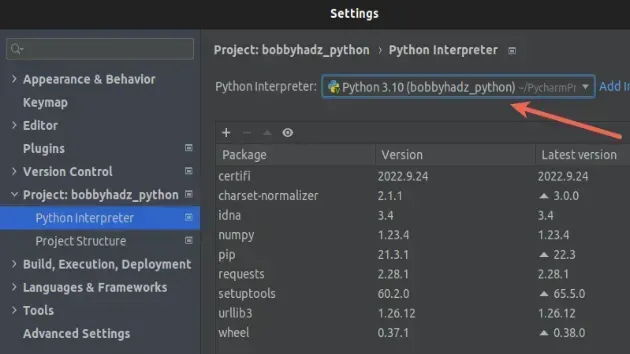
Then Select the correct Python version from the dropdown menu.
You can use the python --version command if you need to get your version of
Python.
python --version python3 --version

# Install requests in Anaconda
To install requests in Anaconda:
- Open your Anaconda Navigator.
- Click on "Environments" and select your project.
- Type
requestsin the search bar to the right. - Tick the
requestspackage and click on "Apply".
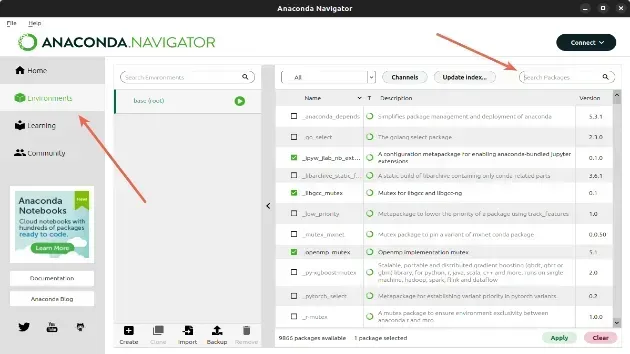
Alternatively, you can install the requests package with a command.
If you are on Windows, search for "Anaconda Prompt" and open the application.
If you are on macOS or Linux, open your terminal.
Run the following command to install the requests package.
# 👇️ Using conda conda install -c anaconda requests # 👇️ Alternatively use `pip` pip install requests # 👇️ For Python 3 pip3 install requests # 👇️ If you get a permissions error sudo pip3 install requests # 👇️ If you don't have pip in your PATH environment variable python -m pip install requests # 👇️ For Python 3 python3 -m pip install requests # 👇️ Using py alias py -m pip install requests # 👇️ Alternative if you get a permissions error pip install requests --user
Click on the following article if you need to install a specific version of the package using Anaconda.
# Install requests in Jupyter Notebook
To install requests in Jupyter Notebook:
- Open your terminal and type "jupyter notebook".

- Click on "New" and then "Terminal" in the browser tab.
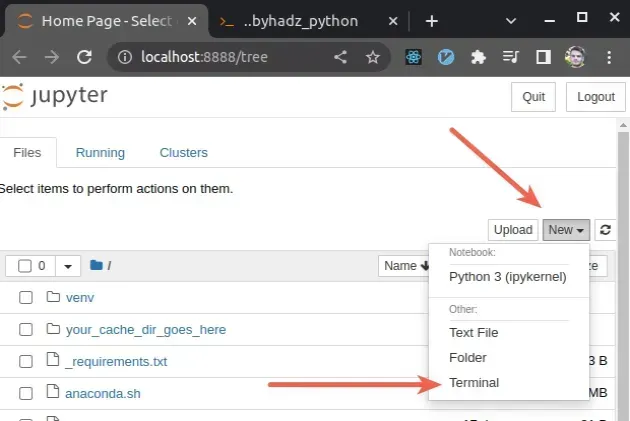
- Type
pip install requestsand press Enter.
# 👇️ Using pip pip install requests # 👇️ For Python 3 pip3 install requests # 👇️ If you get a permissions error sudo pip3 install requests # 👇️ If you don't have pip in your PATH environment variable python -m pip install requests # 👇️ For Python 3 python3 -m pip install requests # 👇️ Using py alias py -m pip install requests # 👇️ Using conda conda install -c anaconda requests # 👇️ Alternative if you get a permissions error pip install requests --user
Alternatively, you can use the Python ipykernel.
- Open your terminal and type "jupyter notebook".

Click on "New" and then click on "Python 3 (ipykernel)".
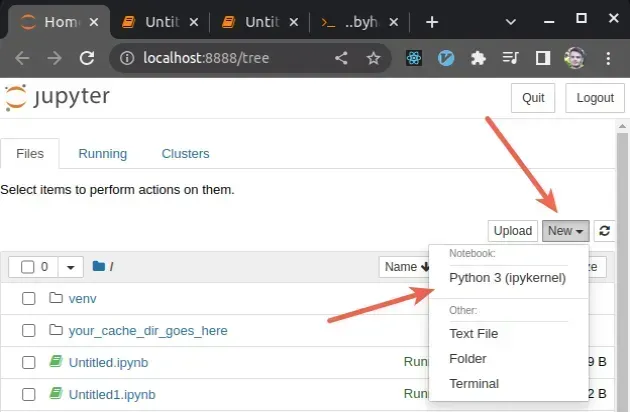
Type
!pip install requestsand click on "Run".

Note that the pip install command must be prefixed with an exclamation mark if
you use this approach.
!pip install requests
Once you type the command, click "Run" to install the requests module.
If you get a permissions error, e.g. "[WinError: 5] Access is denied", add the
--user option to the installation command.
!pip install requests --user

If the error persists, try to restart the Jupyter Kernel and rerun the command.

